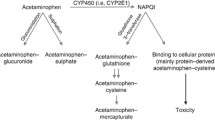Summary
Acetanilide and diphenylhydantoin have a similar first stage biotransformation in that both are oxidized in the para position of the benzene ring incorporated in each of the two molecules.
The elimination of acetanilide from the plasma was studied in thirty healthy volunteer subjects following a single oral dose of 50 mg per kg metabolically active mass (MAM = weight to the power of 0.7). Plasma clearance values varied from 12.4 to 25.11 per hour.
A dose of 5 mg diphenylhydantoin sodium (DPH) per kg MAM was then given thrice daily for 13 days to the same volunteers. The steady state plasma concentrations of DPH varied from 3.4 to 19.6 µg per ml.
Statistically significant correlation was demonstrated between plasma acetanilide clearance and DPH clearance (r=+0.4984).
This finding suggests either a common enzyme acceptor or a common rate-limiting step in the metabolism of the two drugs.
It is possible that the pharmacokinetics of other widely used drugs known to be oxidized, especially phenylbutazone, may also be correlated with the kinetics of acetanilide and of DPH. If this were so, then certain individuals might be at a relatively high risk (due to drug accumulation) of developing adverse effects from drugs metabolized mainly by oxidation, and certain other individuals who metabolize these compounds at a fast rate are likely not to derive therapeutic benefit. A single dose study with simple measurement of acetanilide pharmacokinetics could be used to identify these groups.
Similar content being viewed by others
References
Davies, D. S., Thorgeirsson, S. S.: Mechanism of hepatic drug oxidation and its relationship to individual differences in rates of oxidation in man. Ann. New York Acad. of Sciences179, 411–420 (1971)
Hammer, W.: Martens, S., Sjöqvist, F.: A comparative study of the metabolism of desmethylimipramine, nortriptyline and oxyphenylbutazone in man. Clin. Pharm. Therap.8, 44–49 (1969)
Brodie, B. B., Axelrod, J.: The fate of acetanilide in man. J. Pharmacol. Exper. Ther.94, 29–38 (1948)
Butler, T. C.: The metabolic conversion of 5,5-diphenyl-hydrantoin to 5(p-hydroxyphenyl)-5 phenyl-hydantoin. J. Pharmacol. Exp. Ther.119, 1–11 (1957)
Chang, T., Savory, S., Glazko, A. J.: A new metabolite of 5,5-diphenylhydantoin (Dilantin). Biochem. Biophys. Res. Commun.38, 444–449 (1970)
BorgÅ, O., Garle, M., Gutova, M.: Identification of 5-(3,4 dihydroxyphenyl)-5-phenylhydantoin (phenytoin) in rats and man. Pharmacology7, 129–137 (1972)
Dill, Wesley, A., Kazenko, A., Wolf, L. M., Glazko, A. J.: Studies on 5,5′-diphenylhydantoin (Dilantin) in animals and man. Pharmacol. Exp. Ther.118, 270–279 (1956)
Kozelka, F. L., Hine, C. H.: Degradation products of Dilantin. J. Pharmacol. Exp. Ther.77, 175–179 (1943)
Noach, A. L., Woodbury, D. M., Goodman, L. S.: Studies on the absorption, distribution fate and excretion of 4-C14-labelled diphenylhydantoin. J. Pharmacol. Exp. Ther.122, 301–314 (1958)
Tyrer, J. H., Eadie, M. J., Sutherland, J. M., Hooper, W. D.: Outbreak of anticonvulsant intoxication in an Australian city. B.M.J.4, 271–273 (1970)
Lund, L.: Clinical significance of generic inequivalence of three different pharmaceutical preparations of phenytoin. Eur. J. Clin. Pharmacol.7, 119–124 (1974)
Lund, L., Alván, G., Berlin, A., Alexanderson, B.: Single and multiple dose kinetics of phenytoin in man. Eur. J. Clin. Pharmacol.7, 81–86 (1974)
Drabkin, D. L.: Imperfection: Biochemical phobias and metabolic ambivalences. Perspectives in Biology and Medicine2, 473–517 (1959)
Dill, W. A., Baukema, J., Chang, T., Glazko, A. J.: Colorimetric assay of 5,5-diphenylhydantion (Dilantin) and 5-(p-hydroxyphenyl)-5-phenylhydantoin (35644). Proc. Soc. Exp. Biol., Med.137, 674–679 (1971)
Brodie, B. B., Axelrod, J.: The estimation of acetanilide and its metabolic products, aniline, N-acetyl p-aminophenol and p-aminophenol (free and total conjugated) in biological fluids and tissues. J. Pharmacol. Exp. Ther.94, 22–28 (1948)
Fisher, R. A.: Statistical Methods for Research Workers. 14th Edition. Edinburgh: Oliver and Boyd 1970
Alexanderson, B.: Pharmacokinetics of desmethylimipramine and nortriptyline in man after single and multiple oral doses. A cross-over study. Eur. J. Clin. Pharmacol.5, 1–10 (1972)
Conard, G. J., Haavik, C. O., Finger, K. F.: Binding of 5,5-diphenylhydantoin and its major metabolite to human and rat plasma proteins. J. Pharmaceutical Sciences60, 1642–1646 (1971)
Evans, D. A. P., Manley, K. A., McKusick, V. A.: Genetic control of isoniazid metabolism in man. B.M.J.2, 485–492 (1960)
Evans, D. A. P., White, T. A.: Human acetylation polymorphism. J. Lab. Clin. Med.63, 394–403 (1964)
Renson, J., Weissbach, H., Udenfriend, S.: Hydroxylation of tryptophan by phenylalanine hydroxylase. J. Biol. Chem.237, 2261–2264 (1959)
Pare, C. M. B., Sandler, H., Stacey, R. S.: 5-Hydroxytryptamine deficiency in phenylketonuria. Lancet1959 I, 551–553
Pare, C. M. B., Sandler, H., Stacey, R. S.: The relationship between decreased 5-hydroxyindole metabolism and mental defect in phenylketonuria. Arch. Disease Childhood34, 422–425 (1959)
Pare, C. M. B., Sandler, H., Stacey, R. S.: Decreased 5-hydroxytrytophan decarboxylase activity in phenylketonuria. Lancet1958 II, 1099–1101
Mitoma, C.: Studies on partially purified phenylalanine hydroxylase. Arch. Biochem.60, 476–484 (1956)
Solomon, H. M., Schrogie, J. J.: The effect of phenyramidol on the metabolism of diphenylhydantoin. Clin. Pharmacol. Ther.8, 554–556 (1967)
Orrenius, S.: Molecular aspects of drug metabolism. Proceedings of the Symposium on Biological and Pharmaceutical Aspects of Pharmacokinetics and Therapeutics, Stockholm, 5–6 June, 1970. Acta Pharm. Toxicol.29, Suppl. 3, 191–202 (1971)
Kutt, H., McDowell, F.: Management of epilepsy with diphenylhydantoin sodium. J. American Medical Association203, 969–972 (1968)
Loeser, E. W.: Studies on the metabolism of diphenylhydantoin (Dilantin). Neurology11, 424–429 (1961)
Lund, L., Lunde, P. K., Rane, A., BorgÅ, O., Sjöqvist, F.: Plasma protein binding, plasma concentrations and effects of diphenylhydantoin in man. Ann. New York Acad. Sciences179, 723–728 (1971)
Dawson, K. P., Jamieson, A.: Value of blood phenytoin estimation in management of childhood epilepsy. Arch. of Dis. Childhood46, 386–388 (1971)
Author information
Authors and Affiliations
Rights and permissions
About this article
Cite this article
Cunningham, J.L., Bullen, M.F. & Price Evans, D.A. The pharmacokinetics of acetanilide and of diphenylhydantoin sodium. Eur J Clin Pharmacol 7, 461–466 (1974). https://doi.org/10.1007/BF00560359
Received:
Accepted:
Issue Date:
DOI: https://doi.org/10.1007/BF00560359




